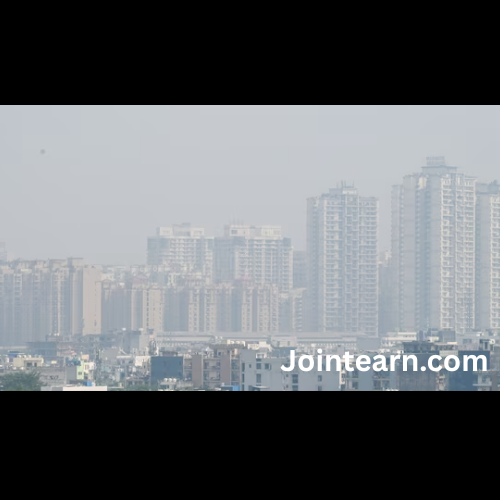
Delhi and the wider National Capital Region (NCR) are once again confronting the severe health impacts of air pollution, with residents reporting a wide range of symptoms from burning eyes and headaches to disturbed sleep. A recent survey by citizen engagement platform LocalCircles, based on over 44,000 responses, highlights how the polluted environment is affecting daily life across Delhi, Gurugram, Noida, Faridabad, and Ghaziabad.
Severe Air Quality Post-Diwali
Analysis of Central Pollution Control Board (CPCB) data revealed that PM2.5 levels spiked to 488 micrograms per cubic metre after Diwali — the highest in five years — exceeding three times the pre-Diwali level of 156.6. The surge comes despite measures to restrict pollution, including the use of green firecrackers during celebrations.
The survey indicated that nearly three out of four households are facing health issues due to air pollution. Key findings include:
- 42% of households reported sore throat or cough among family members.
- 25% experienced burning eyes, headaches, or difficulty sleeping.
- 17% reported breathing difficulties or aggravated asthma.
Residents Taking Precautions
LocalCircles’ survey shows that citizens are actively attempting to reduce exposure to the toxic air:
- 44% of households are minimizing outdoor activities. Many are also boosting immunity through diet and supplements.
- Around 30% have either consulted or plan to consult doctors for pollution-related health issues.
Despite a reported 77.5% reduction in stubble burning in Punjab and Haryana due to floods and delayed harvests, Delhi’s Air Quality Index (AQI) remains critically high. On Saturday morning, the overall AQI for Delhi was recorded at 261 (“poor” category), slightly down from 290 the previous day.
Specific areas of concern include:
- Anand Vihar: AQI of 412 (“severe”) — the highest in the city.
- Bawana: AQI of 336 (“very poor”).
- ITO: AQI of 248 (“poor”).
- Dwarka: AQI of 276 (“poor”).
The distribution of pollution across the city indicates that toxic air is not localized but widespread, affecting residents throughout the capital.
Government Measures to Curb Pollution
To tackle rising pollution, the Delhi government has implemented Stage 2 of the Graded Response Action Plan (GRAP) across Delhi-NCR. Some of the steps already in action include:
- Deployment of truck-mounted water sprinklers, including on busy roads like Janpath, to reduce dust and particulate matter.
- Planning for cloud seeding operations to induce artificial rain. CM Rekha Gupta announced that the government intends to try cloud seeding in Delhi between October 28 and 30 as an experimental measure to control pollution levels.
These interventions aim to temporarily lower particulate matter in the atmosphere and provide relief to residents, especially vulnerable groups.
Doctors Warn of Health Impacts
Medical experts have cautioned about the serious health implications of sustained exposure to high pollution levels. Former AIIMS director Dr Randeep Guleria said the current pollution is causing acute health effects, particularly among the elderly, children, and individuals with heart or lung conditions.
He added that even healthy individuals are reporting symptoms such as:
- Nasal stuffiness
- Throat pain
- Chest tightness
- Persistent coughing
According to Dr Guleria, these symptoms are caused by inflammation and narrowing of the airways due to pollutants. He also pointed out that Diwali celebrations, despite the use of ‘green’ firecrackers, exacerbated air pollution, pushing PM2.5 levels dangerously high.
Doctors recommend basic preventive measures, including limiting outdoor exposure, wearing protective masks, and monitoring symptoms among vulnerable family members.
Public Sentiment and Awareness
The LocalCircles survey highlights widespread concern and awareness among residents. Citizens are increasingly conscious of the health risks posed by the deteriorating air quality and are taking proactive measures, from diet adjustments to limiting outdoor activities.
The survey underscores that while government interventions like GRAP and cloud seeding may provide temporary relief, long-term solutions will require a multi-pronged approach including:
- Strict regulation of vehicular emissions
- Enforcement against illegal burning of waste and stubble
- Promotion of cleaner fuels and energy sources
- Public awareness campaigns about personal protection and health precautions
Conclusion
Delhi-NCR’s struggle with air pollution continues to affect millions of residents, causing respiratory and cardiovascular issues, discomfort, and disruption in daily life. Despite efforts such as green cracker policies, dust suppression, and planned artificial rainfall, the AQI remains dangerously high, especially in hotspots like Anand Vihar and Bawana.
As winter approaches, and the pollution season peaks, both citizens and government authorities face a race against timeto mitigate the health impact. Experts warn that collective action, stringent enforcement of regulations, and awareness among residents are essential to prevent long-term health crises caused by toxic air.
The current scenario is a stark reminder of the urgent need for sustainable pollution control measures to protect the health and well-being of Delhi-NCR residents.


Leave a Reply